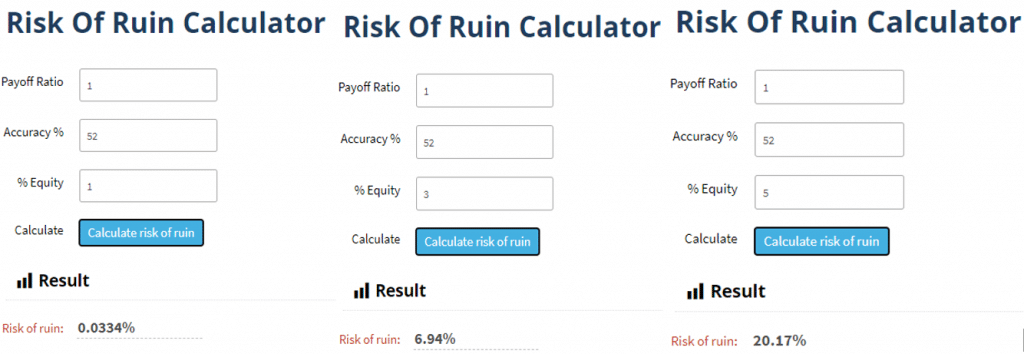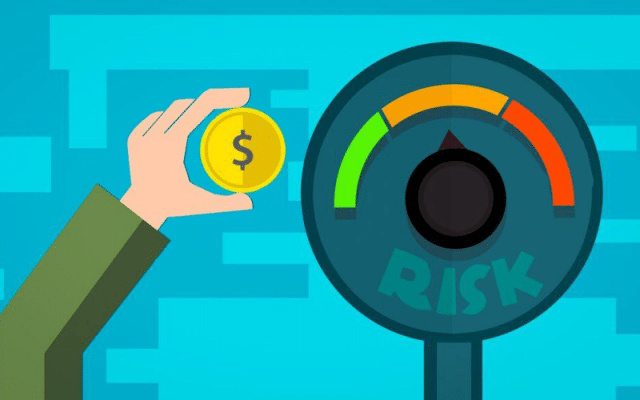Risk management in forex goes beyond the common risk-to-reward or allocating 1% or 2% of a trading account. One of the overlooked metrics more people should consider is a concept known as ‘risk of ruin,’ which refers to the probability of a trader blowing their account or losing a substantial portion.
Although this idea may seem intimidating, it’s one of the simple statistics to know the longevity of a trading strategy based on its average win rate and reward payoff.
What is the risk of ruin?
Risk of ruin (or probability of ruin) refers to the likelihood of a trader losing all of their capital in a trading account (or at least enough to make it impossible to recover the losses).
The mathematical calculation for risk of ruin considers a trader’s win accuracy, expected reward, and maximum drawdown. Such an idea is also frequently referenced in gambling, a field drawing many similarities to a financial market like forex.
In gambling forms such as blackjack or others where the reward is known in advance, gamblers implement risk of ruin to identify the possibility of them losing a significant portion of their bankroll.
What makes it challenging in forex is even if we use a so-called risk-to-reward, the reward is never guaranteed, meaning the concept of risk of ruin is even more critical.
While it is an uncomfortable idea to think of ‘ruining one’s account,’ it is something to seriously consider.
Why is the risk of ruin a crucial concept?
A common mistake made by many is perceiving risk in two strands: the winning accuracy and also the risk-to-reward. This approach is clearly two-dimensional and does not consider another element of the entire puzzle, which is the percentage a person risks per position.
Risk of ruin comes into play here because even if one has a favorable risk-to-reward ratio (let’s assume 1:2) and a winning percentage of 35%, if they allocate 10% of their account in one position, there is about a 60% chance of them blowing up (further calculations in the following section).
A losing streak of four trades would leave the trader 30% down, making the recovery more challenging based on these statistics. On a rare occasion, a longer sequence drastically increases the chance of a blow-up.
Appreciating this concept’s significance helps us see why capital preservation is one of the most remarkable skills any trader can have. The aim is to have an edge in trading that makes it virtually inconceivable to lose all or a massive part of the trading capital. In other words, risk small.
The risk of ruin is one of the reasons why much of the trading literature suggests risking 1 to 2% of your overall equity.
To get the best out of calculating the risk of ruin, the trader must fully forward-test their trading strategy to know their average winning percentage and risk-to-reward (as we’ll see in the following examples).
Fortunately, rather than using a manual calculation, there are several risk of ruin calculators freely available online.
Examples using the different risk of ruin statistics
Let’s look at three different examples that exemplify how a seemingly slight increase in the percentage risked drastically amplifies the risk of ruin. In the images below, let’s assume a trader has an average risk-to-reward of 1:1 with a 52% winning accuracy.
It’s clear to observe the differences between allocating 1%, 3%, and 5% and how each affects the risk of ruin.

Methods of reducing the risk of ruin
Unfortunately, there is no universally accepted risk of ruin percentage because it’s dependent on so many factors. What could be easily agreed upon is any trader desires to aim for a risk to ruin figure that is less than what they aim to net per position.
For example, if a trader grows an account by 5%, an ideal risk of ruin would have to be lower than this. Of course, this is an idealistic scenario, but if we observe some of the tips below, we’ll see this notion is one of the threads for dealing with this challenge.
Risk only up to 2-3% of the trading account
As mentioned previously, one way of ensuring a reasonable risk of ruin is by never risking more than 3% (which might be high for some) on any given position.
This rule may not be hard and fast, but as we saw in the previous example of how a jump from 1% to 5% can affect the result, it is the foundation of money management.
Improve the reward for every position
Although this tweak is challenging to implement, having a higher reward in relation to the risk is a solid method for improving the risk of ruin. It is easier than improving the win rate because that is beyond our control.
One method of achieving this is holding positions for a longer period while locking in some portion of the profit.

Factoring the likelihood of losing streaks and drawdown
This point is probably the most critical and does relate to using suitable positions, as mentioned previously. The table above is an excellent tool assessing the likelihood of losing streaks in a sequence of 100 trades (based on different win rates).
Of course, there is no right drawdown percentage as it’s dependent on so many variables. Though to be on the safe side, a reasonable drawdown shouldn’t exceed 20%. So, by understanding this, the risk-to-reward and win rate, a trader can use such data for the risk of ruin.
Final word
The risk of ruin shouldn’t be a difficult concept to understand the importance of in forex. It also shows that knowing other statistics like the average reward, losing streaks, and win percentage provide expectations of how a specific trading system will pan out in the long run.
No matter how confident a trader is about their abilities, no one can be successful for long if they have a high chance of ruining their account.




